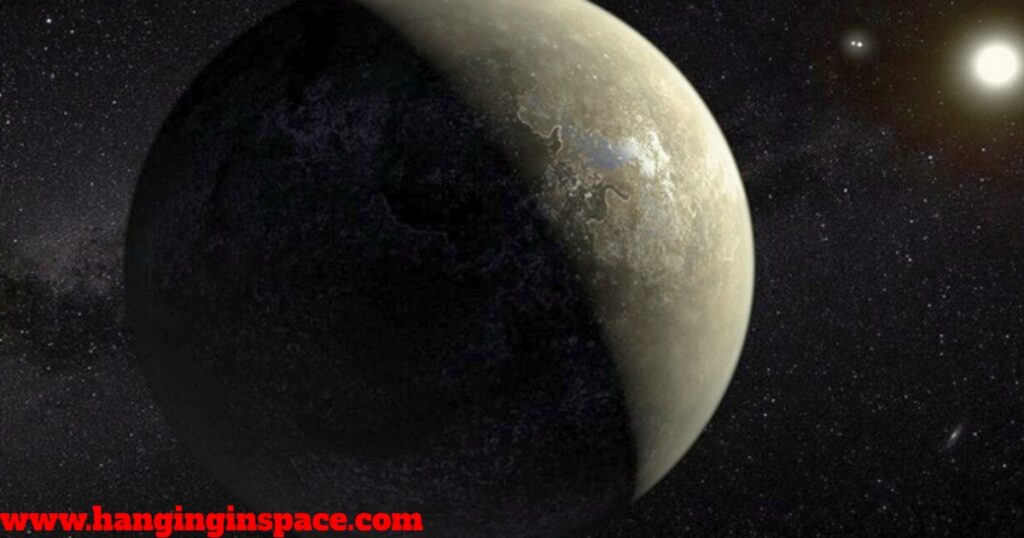Proxima Centauri b is a rocky exoplanet, meaning it’s a planet orbiting a star outside our solar system and is thought to be composed primarily of rock and metal. Orbiting the red dwarf star Proxima Centauri, it holds the title of the closest exoplanet to Earth ever discovered. Proxima Centauri b is estimated to be slightly larger than Earth, with a mass of about 1.27 times our planet’s.
However, unlike Earth, Proxima Centauri b orbits its star (Proxima Centauri) at a very close distance, completing a full revolution in just 11.18 days. This proximity places Proxima b within the star’s habitable zone, the region where liquid water could potentially exist on a planet’s surface. Proxima Centauri b is a potential second earth.

When and Who Discovered Proxima Centauri b?
The discovery of Proxima b is a story of the power of collaboration.
Early Efforts (1990s):
Astronomers were already interested in the possibility of planets orbiting Proxima Centauri, the closest star to our solar system. During the 1990s, they used radial velocity methods to search for potential wobble in the star’s movement, which could be caused by an orbiting planet. However, the technology at the time wasn’t sensitive enough to conclusively detect a planet.
The Pale Red Dot Project (2016):
In 2016, a team of astronomers led by Guillem Anglada-Escudé launched the Pale Red Dot project. This project aimed to use high-precision radial velocity measurements from two instruments at the European Southern Observatory (ESO) in Chile:
HARPS (High Accuracy Radial Velocity Planet Searcher) on the 3.6-meter Telescope.
UVES (Ultraviolet Echelle Spectrograph) on the larger 8-meter Very Large Telescope (VLT).
The Signal Emerges (Early 2016):
Data collected over several years using these high-precision instruments revealed subtle wobbles in the movement of Proxima Centauri. These wobbles were consistent with the gravitational pull of a planet orbiting the star.
Confirmation & Announcement (August 2016):
After careful analysis and confirmation, the team led by Anglada-Escudé announced the discovery of Proxima b on August 24, 2016. The discovery was a major breakthrough, capturing the attention of scientists and the public. Proxima b became the closest known exoplanet to Earth.
What is the Estimated Size of Proxima Centauri b?
Undetermined directly. Estimates based on mass and density place the radius around 1.1 times Earth’s radius, which translates to roughly 6,650 kilometers (4,130 miles).
Following the radius estimate, the estimated diameter of Proxima Centauri b would be approximately 13,300 kilometers (8,260 miles).
What is the Estimated Mass & Volume of Proxima Centauri b?
The Mass of Proxima Centauri B is estimated to be at least 1.27 times the mass of Earth. This equates to roughly 1.3 Earth masses. The Volume of Proxima Centauri B is calculated to be about 1.6 times the volume of Earth.
What is the Estimated Temperature of Proxima Centauri b?
Due to the tidal locking scenario (potentially tidally locked with one side facing the star constantly), surface temperature estimates vary greatly. The day side facing the star could reach scorching temperatures upwards of 150°C (300°F), while the night side might be frigid, well below -100°C (-150°F).
The true temperature distribution depends on factors like atmospheric composition and heat transfer.
What is Proxima Centauri b’s Estimated Distance from Earth?
Proxima Centauri b is not directly measurable from Earth. However, its host star, Proxima Centauri, is the closest star system to our solar system, located approximately 4.24 light-years away. Since Proxima Centauri b orbits Proxima Centauri, the distance from Earth to the planet is essentially the same as the distance to the star system.

What is the Composition, Interior Structure & Atmosphere of Proxima Centauri b?
Due to the immense challenges of directly observing Proxima b, our knowledge of its composition, interior, and atmosphere remains limited. However, estimates are made by scientists by using various methods
Composition of Proxima Centauri b:
Likely Rocky: Based on mass estimates (around 1.27 times Earth’s mass) and density, Proxima b is likely a rocky planet similar to Earth or Mars, composed primarily of heavier elements like iron, silicon, and oxygen.
Interior Structure of Proxima Centauri b:
Similar to Earth (Maybe): Assuming a rocky composition, Proxima b’s interior could be structured similarly to Earth’s, with a core of iron and nickel, a mantle of silicate rock, and potentially a crust on the surface.
Atmosphere of Proxima Centauri b:
Possible Scenario: The strong radiation from Proxima Centauri, a red dwarf star, could potentially strip away any atmosphere the planet might have. Additionally, the tidal locking scenario could lead to atmospheric loss on the hot day side.
The Habitability Question:
The question of whether Proxima b could support life is a subject of ongoing debate. While it falls within the habitable zone, Proxima Centauri is a flare star, meaning it experiences frequent outbursts of radiation that could potentially strip away any atmosphere a planet might possess.
Additionally, the tidal forces exerted by the star’s strong gravity could lead to Proxima b being tidally locked, meaning one side would be constantly facing the star, creating scorching temperatures on the day side and perpetual darkness on the night side.
Future Exploration:
Despite these challenges, Proxima b remains a prime target in the search for extraterrestrial life. Its proximity to Earth makes it a prime candidate for future study with next-generation telescopes. These telescopes could potentially detect signs of an atmosphere, determine its composition, and even search for biosignatures, potential chemical signatures indicative of life.
Proxima Centauri b as compared to Earth:
Proxima b Vs. Earth
| Feature | Earth | Proxima b |
|---|---|---|
| Star | Sun (G-type main sequence star) | Proxima Centauri (M-dwarf star) |
| Distance from Star | 1 Astronomical Unit (AU) | 0.0485 AU (much closer) |
| Orbital Period | 365.25 days (1 year) | 11.186 days |
| Temperature | Average: 15°C (59°F) | Estimated surface temperature: -40°C to +30°C (-40°F to 86°F) |
| Atmosphere | Nitrogen-oxygen rich atmosphere | Likely has an atmosphere, but composition unknown |
| Magnetic Field | Strong global magnetic field | Magnetic field existence unknown |
| Water | Abundant liquid water on the surface | Potential for liquid water, but depends on atmospheric properties |
| Life | Supports a wide variety of life forms | Habitability potential uncertain; further study needed |
Conclusion:
Proxima b serves as a constant reminder of the vastness and potential diversity of our universe. As we continue to explore the universe, this nearby world will undoubtedly remain a focal point in our search for life beyond Earth. The Proxima Centauri system, which also includes the binary stars Alpha Centauri A and B, is the closest star system to our own.
Studying Proxima b paves the way for a deeper understanding of exoplanets and potentially opens doors to future interstellar exploration. While visiting Proxima b with current technology is far-fetched, the discovery of this intriguing world ignites our curiosity and fuels the fire of human exploration.
